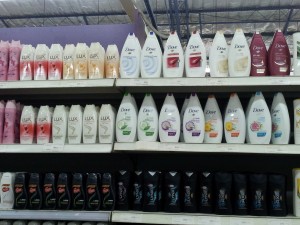Something I find amusing is that most African women use not only hair extensions but also wigs. I went to a Nakumatt supermarket in Nairobi, and I was amazed at the space dedicated to wigs! Women change their hairstyle so often that at times I’ve a hard time recognizing faces. This is but an indication that personal care products are one of the booming markets in East Africa. Other growing markets are South Africa and Nigeria.

This growth is driven by a growing population – and in particular, the fastest growing middle-class population in the world – increasing urbanization, and improved business regulation, according to a report by Roland Berger. In fact, these factors are behind the general growth of fast moving consumer products in Africa. A KPMG report indicates some additional drivers: Africans’ willingness to spend a proportionately large share of their incomes on beauty products due to their greater exposure to Western culture, improving levels of education, the youthfulness of the population, and the rise of female independence.
Important challenges to penetrate this market include:
- the need to adapt the products to local consumers’ needs: for instance, make-up needs to be adapted to skin color and texture. Kenyan entrepreneur Suzie Wokabi created her cosmetics company SuzieBeauty. Its product line is featured as “a bespoke product for the African woman, by an African woman.”
- accessing the distribution network: while formal distribution channels are expanding, most distribution takes place through the traditional system. Penetrating this system is not an easy endeavor.

It seems to me that, given their local knowledge, indigenous companies are in better shape than foreign competitors to face these challenges. Foreign competitors may be better off if they go hand-in-hand with local ones. This is the route India’s Godrej has taken: they began with a partial acquisition (51%) of the Kenya-based Darling Group – a leader in hair extensions operating in 14 African countries; the acquisition was completed in February this year.


Hi Africa! I don’t know if you remember me, I was a GEMBA 2012 student and I studied two topics with you! I’m living in Timor-Leste, an island in Asia (half of an Indonesian island and near Australia) and one of the things I noticed when I arrived here two years ago, was exactly the adaptation of the personal care and beauty products to the Indonesian market.
All the products are “whitening” and I questioned the size of the containers… Most of them are quite small and you have shampoos, shower gel, hair conditioners, etc, with a size of 50 ml. At the beginning I thought it was bizarre, as I was used to the western big-size containers, but then I realized that this was the only way of having the populating buying personal care products. Their income is quite low and many times they only can afford to buy products with a cost under $1 USD.
With a small size, most of these products cost cents of dollar (USD is the currency used in Timor-Leste). And you can see this pattern in all Asian countries!
Of course I remember you, Mafalda! Good to hear from you!
What you say about product size is quite common in emerging markets precisely because of the reasons you indicate. And it applies to other types of products as well. For instance, I was surprised to learn that Kenyan farmers (may be those from other countries as well) buy medicines for the cows by the unit. Isn’t this quite interesting to us from other countries?
Yes it is quite interesting! But don’t go any further… Here in Timor-Leste, if I go to a pharmacy to buy medicines they only sell me by unit. For instance, if the doctor subscribes 10 units, they don’t sell me an entire box, but only 10 units! But in the end I think it makes sense. Does not the western way leading us to a society where we waste a lot of resources?…
Very true, Mafalda: if we were more careful in terms of the use of resources, maybe others would be better of in terms of basic living standards…
Usseful information. Lucky me I found your web site by chance, and I’m surprised why this twist
of fate did not came about in advance! I bookmarked it.
I’m glad you found it useful, Margaret!
Very nice post. I just stumbled upon your blog and wanted to say that I have really enjoyed surfing around your blog posts. In any case I will be subscribing to your feed and I hope you write again soon!
I’m gald you enjoyed the blog, Leatrice, and look forward to your contributions to it!